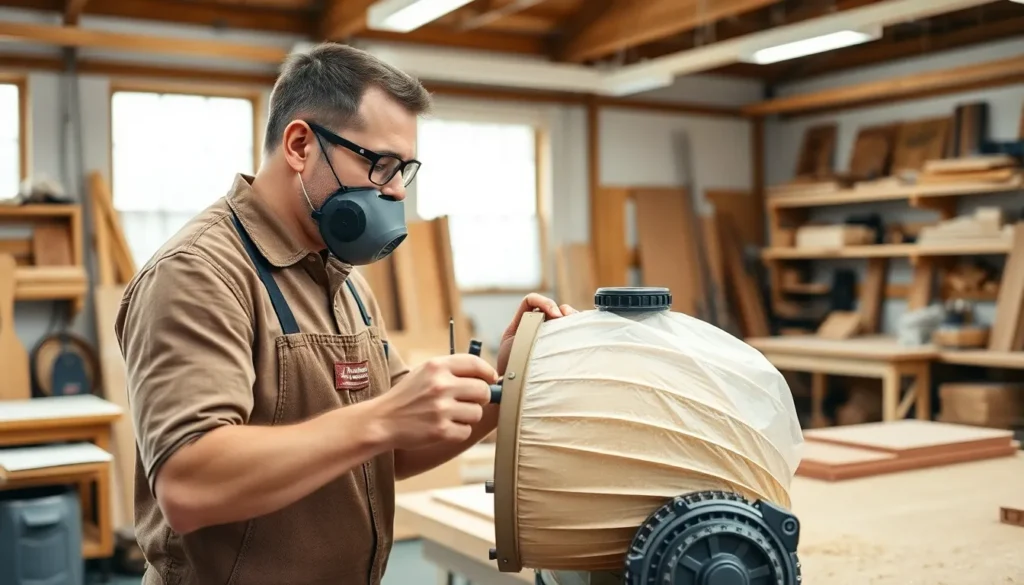Every woodworker knows the struggle: you’re crafting a masterpiece, and suddenly, you’re engulfed in a cloud of sawdust. It’s like your workshop just transformed into a scene from a bad horror movie. Enter the woodworking dust collector—the unsung hero of the shop that swoops in to save the day. Not only does it keep the air clear, but it also ensures that those intricate details of your work stay pristine.
Imagine working on your latest project without the constant sneeze-inducing interruptions. A good dust collector doesn’t just make cleanup a breeze; it enhances your creativity by providing a cleaner, safer workspace. So, if you’re serious about your craft and want to keep your workshop from looking like a lumberjack’s sneeze, it’s time to invest in a dust collector that’ll have you breathing easy while you bring your woodworking dreams to life.
Woodworking Dust Collector
A woodworking dust collector is a vital tool designed to manage and eliminate sawdust and debris generated during woodworking activities. Such devices capture fine particles, preventing them from circulating in the workshop air. The main components include an air filtration system, a collection bag, and a motor that creates suction.
Dust collectors come in various types, including portable units and stationary systems. Portable units offer flexibility, allowing woodworkers to move them around as needed. Stationary systems, on the other hand, provide more power and are typically installed in a fixed location within the workshop.
Filtration efficiency is a critical factor when selecting a dust collector. Quality systems filter particles down to 1 micron or smaller, ensuring cleaner air for the woodworker. HEPA filters are an excellent choice for those concerned about allergens or respiratory issues.
Performance metrics include airflow rate, measured in cubic feet per minute (CFM). Units with higher CFM ratings can handle larger volumes of dust, making them more effective for bigger projects. Some models feature variable speed settings to adjust suction based on the task at hand.
Woodworking dust collectors not only enhance workspace cleanliness but also contribute to safety. Excessive sawdust accumulation poses fire risks, while breathing in dust can lead to long-term health problems. Investing in a reliable dust collector significantly reduces these hazards and promotes a healthier work environment.
Overall, a woodworking dust collector proves essential for anyone serious about woodworking. With improved air quality and workspace organization, creativity can flourish without interruptions caused by cleanup efforts.
Importance of a Woodworking Dust Collector

A woodworking dust collector plays a crucial role in maintaining a safe and clean workspace. Effective dust management improves overall woodworking experiences.
Health Benefits
Respiratory health receives significant improvement with proper dust collection. Fine dust particles, often invisible, pose serious health risks when inhaled. Many woodworkers face allergies or respiratory issues due to prolonged exposure to sawdust. Dust collectors equipped with HEPA filters capture particles down to 0.3 microns, providing an essential barrier against harmful allergens. Reducing airborne dust not only protects lungs but also decreases instances of irritation, enhancing overall well-being in the workshop.
Improved Work Environment
A cleaner workspace fosters creativity and productivity among woodworkers. Without constant interruptions due to dust accumulation, focus on projects improves. Efficient dust collection minimizes the need for frequent cleanups, allowing more time for actual woodworking tasks. Moreover, effective systems prevent sawdust buildup on tools and surfaces, prolonging their lifespan. Simplifying cleanup processes contributes to a more organized and pleasant working environment, ultimately making the craft more enjoyable.
Types of Woodworking Dust Collectors
Woodworking dust collectors come in various types, each serving distinct purposes. Understanding these types helps woodworkers choose the right system for their needs.
Bag Collectors
Bag collectors utilize a fabric bag to capture and contain sawdust and debris. These systems operate effectively for small to medium-sized workshops. Various bag sizes allow for customized filtering options, making it feasible to match performance levels to specific projects. Generally, bag collectors filter particles down to about 5 microns, though some high-efficiency models can achieve smaller sizes. Maintenance remains straightforward, with easy bag replacements available for continued use, enhancing convenience. Budget-conscious woodworkers often prefer bag collectors due to their lower initial costs and solid performance for casual projects.
Cyclone Collectors
Cyclone collectors represent a more advanced dust collection solution featuring a spinning cyclone action to separate particles from the airstream. These systems capture fine dust and larger debris simultaneously, improving overall efficiency. Typically, cyclone collectors filter particles down to 1 micron or lower, appealing to serious woodworkers. Increased airflow ratings enhance performance, making them suitable for larger shops and more extensive operations. Installation involves a more complex setup but ensures long-term durability and effectiveness. Cyclone collectors save time by reducing frequent bag changes, affording woodworkers a cleaner and safer workspace.
How to Choose the Right Woodworking Dust Collector
Choosing the right woodworking dust collector involves understanding specific needs and preferences. Attention to crucial factors shapes the decision-making process.
Factors to Consider
Power rating is essential, as higher airflow rates (measured in CFM) accommodate larger spaces more effectively. Size matters; small workshops benefit from portable collectors, while large facilities require stationary models for optimal performance. Filtration efficiency deserves consideration too. Models with HEPA filters capture particles down to 0.3 microns, offering significant health benefits. The collection capacity of the dust bag or bin influences frequency of emptying, impacting overall workflow. Added features like noise reduction and ease of maintenance enhance usability and user satisfaction.
Common Pitfalls to Avoid
Skimping on filtration quality leads to poor air quality, increasing respiratory risks. Choosing a dust collector solely based on price often results in underperformance or frequent replacements. Ignoring the size of the workshop risks inefficiency; a collector too small for the space can cause more problems than it solves. Underestimating the importance of manufacturer support can complicate repairs down the line. Overlooking noise levels may create an uncomfortable working environment that detracts from productivity. Without careful consideration of these pitfalls, a woodworker may find their investment ineffective and the workspace less enjoyable.
Maintenance Tips for Woodworking Dust Collectors
Regular maintenance ensures optimal performance of woodworking dust collectors. Clean the filters frequently to prevent clogs, which reduces suction efficiency. Check the collection bags or bins regularly. Empty them when they are filled to about two-thirds capacity to maintain maximum airflow.
Inspect the hoses for any signs of wear or damage. Damaged hoses can lead to leaks, diminishing the effectiveness of dust collection. Ensure connections are secure to avoid any disruptions in the system.
Test the motor and other components periodically. Listen for unusual sounds that may indicate issues, as they can affect the dust collector’s operation. Lubricate moving parts as specified by the manufacturer, which helps extend the life of the machine.
Consider a schedule for comprehensive cleaning. Dust buildup on the exterior of the dust collector can affect cooling and motor function. Wipe down surfaces with a damp cloth to keep the unit looking good and functioning well.
Assess the airflow by using a manometer or an airflow meter. This step verifies that suction remains strong and can indicate when maintenance is required. Scheduling routine check-ups can prevent major repairs down the line.
Stay informed about the specific maintenance recommendations for the dust collector model in use. Reviewing the user manual provides critical information on how to maintain filters and other essential components, enhancing overall functionality. These practices lead to a more efficient and reliable workspace, enabling woodworkers to focus on their craft without distractions.
Conclusion
Investing in a woodworking dust collector is essential for any serious woodworker. It not only enhances workspace cleanliness but also significantly improves health and safety. By effectively capturing fine dust particles it allows woodworkers to focus on their craft without the constant interruptions of cleanup.
Choosing the right dust collector tailored to specific needs can make a world of difference. Whether opting for a portable bag collector or a more powerful cyclone system each type offers unique benefits that contribute to a better working environment. Regular maintenance ensures these tools perform optimally and last longer.
With the right dust collector in place woodworkers can enjoy a cleaner safer and more productive workspace. This investment is a step toward fostering creativity and enhancing the overall woodworking experience.

